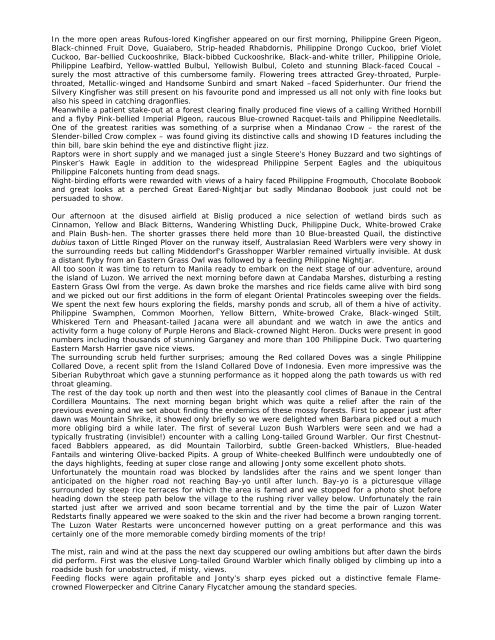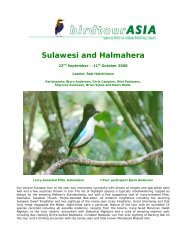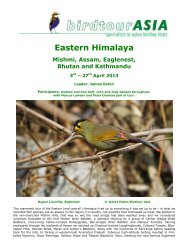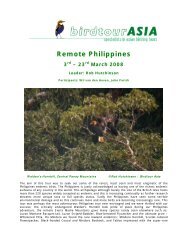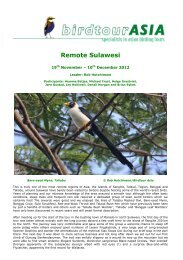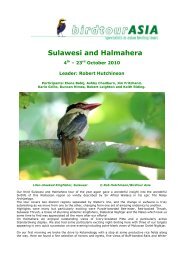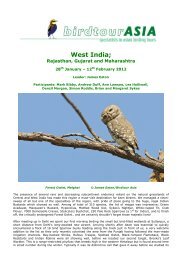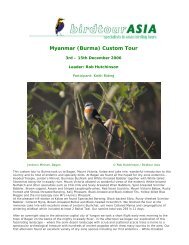The Philippines - Birdtour Asia
The Philippines - Birdtour Asia
The Philippines - Birdtour Asia
Create successful ePaper yourself
Turn your PDF publications into a flip-book with our unique Google optimized e-Paper software.
In the more open areas Rufous-lored Kingfisher appeared on our first morning, Philippine Green Pigeon,<br />
Black-chinned Fruit Dove, Guaiabero, Strip-headed Rhabdornis, Philippine Drongo Cuckoo, brief Violet<br />
Cuckoo, Bar-bellied Cuckooshrike, Black-bibbed Cuckooshrike, Black-and-white triller, Philippine Oriole,<br />
Philippine Leafbird, Yellow-wattled Bulbul, Yellowish Bulbul, Coleto and stunning Black-faced Coucal –<br />
surely the most attractive of this cumbersome family. Flowering trees attracted Grey-throated, Purplethroated,<br />
Metallic-winged and Handsome Sunbird and smart Naked –faced Spiderhunter. Our friend the<br />
Silvery Kingfisher was still present on his favourite pond and impressed us all not only with fine looks but<br />
also his speed in catching dragonflies.<br />
Meanwhile a patient stake-out at a forest clearing finally produced fine views of a calling Writhed Hornbill<br />
and a flyby Pink-bellied Imperial Pigeon, raucous Blue-crowned Racquet-tails and Philippine Needletails.<br />
One of the greatest rarities was something of a surprise when a Mindanao Crow – the rarest of the<br />
Slender-billed Crow complex – was found giving its distinctive calls and showing ID features including the<br />
thin bill, bare skin behind the eye and distinctive flight jizz.<br />
Raptors were in short supply and we managed just a single Steere’s Honey Buzzard and two sightings of<br />
Pinsker’s Hawk Eagle in addition to the widespread Philippine Serpent Eagles and the ubiquitous<br />
Philippine Falconets hunting from dead snags.<br />
Night-birding efforts were rewarded with views of a hairy faced Philippine Frogmouth, Chocolate Boobook<br />
and great looks at a perched Great Eared-Nightjar but sadly Mindanao Boobook just could not be<br />
persuaded to show.<br />
Our afternoon at the disused airfield at Bislig produced a nice selection of wetland birds such as<br />
Cinnamon, Yellow and Black Bitterns, Wandering Whistling Duck, Philippine Duck, White-browed Crake<br />
and Plain Bush-hen. <strong>The</strong> shorter grasses there held more than 10 Blue-breasted Quail, the distinctive<br />
dubius taxon of Little Ringed Plover on the runway itself, Australasian Reed Warblers were very showy in<br />
the surrounding reeds but calling Middendorf’s Grasshopper Warbler remained virtually invisible. At dusk<br />
a distant flyby from an Eastern Grass Owl was followed by a feeding Philippine Nightjar.<br />
All too soon it was time to return to Manila ready to embark on the next stage of our adventure, around<br />
the island of Luzon. We arrived the next morning before dawn at Candaba Marshes, disturbing a resting<br />
Eastern Grass Owl from the verge. As dawn broke the marshes and rice fields came alive with bird song<br />
and we picked out our first additions in the form of elegant Oriental Pratincoles sweeping over the fields.<br />
We spent the next few hours exploring the fields, marshy ponds and scrub, all of them a hive of activity.<br />
Philippine Swamphen, Common Moorhen, Yellow Bittern, White-browed Crake, Black-winged Stilt,<br />
Whiskered Tern and Pheasant-tailed Jacana were all abundant and we watch in awe the antics and<br />
activity form a huge colony of Purple Herons and Black-crowned Night Heron. Ducks were present in good<br />
numbers including thousands of stunning Garganey and more than 100 Philippine Duck. Two quartering<br />
Eastern Marsh Harrier gave nice views.<br />
<strong>The</strong> surrounding scrub held further surprises; amoung the Red collared Doves was a single Philippine<br />
Collared Dove, a recent split from the Island Collared Dove of Indonesia. Even more impressive was the<br />
Siberian Rubythroat which gave a stunning performance as it hopped along the path towards us with red<br />
throat gleaming.<br />
<strong>The</strong> rest of the day took up north and then west into the pleasantly cool climes of Banaue in the Central<br />
Cordillera Mountains. <strong>The</strong> next morning began bright which was quite a relief after the rain of the<br />
previous evening and we set about finding the endemics of these mossy forests. First to appear just after<br />
dawn was Mountain Shrike, it showed only briefly so we were delighted when Barbara picked out a much<br />
more obliging bird a while later. <strong>The</strong> first of several Luzon Bush Warblers were seen and we had a<br />
typically frustrating (invisible!) encounter with a calling Long-tailed Ground Warbler. Our first Chestnutfaced<br />
Babblers appeared, as did Mountain Tailorbird, subtle Green-backed Whistlers, Blue-headed<br />
Fantails and wintering Olive-backed Pipits. A group of White-cheeked Bullfinch were undoubtedly one of<br />
the days highlights, feeding at super close range and allowing Jonty some excellent photo shots.<br />
Unfortunately the mountain road was blocked by landslides after the rains and we spent longer than<br />
anticipated on the higher road not reaching Bay-yo until after lunch. Bay-yo is a picturesque village<br />
surrounded by steep rice terraces for which the area is famed and we stopped for a photo shot before<br />
heading down the steep path below the village to the rushing river valley below. Unfortunately the rain<br />
started just after we arrived and soon became torrential and by the time the pair of Luzon Water<br />
Redstarts finally appeared we were soaked to the skin and the river had become a brown ranging torrent.<br />
<strong>The</strong> Luzon Water Restarts were unconcerned however putting on a great performance and this was<br />
certainly one of the more memorable comedy birding moments of the trip!<br />
<strong>The</strong> mist, rain and wind at the pass the next day scuppered our owling ambitions but after dawn the birds<br />
did perform. First was the elusive Long-tailed Ground Warbler which finally obliged by climbing up into a<br />
roadside bush for unobstructed, if misty, views.<br />
Feeding flocks were again profitable and Jonty’s sharp eyes picked out a distinctive female Flamecrowned<br />
Flowerpecker and Citrine Canary Flycatcher amoung the standard species.


